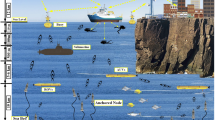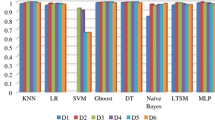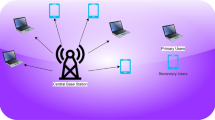Abstract
With the advances in technology, there has been an increasing interest both from research and industrial communities in the use of Underwater Wireless Sensor Networks (UWSNs). These networks are vulnerable to a wide class of security attacks. In fact, UWSNs are particularly more susceptible to attacks than their ground-base counterparts due to the challenges imposed by their deployment environment. This paper proposes a distributed approach to detect and mitigate routing attacks in such networks. An analytical model is provided to capture the interactions between various contributing parameters. Our simulation experiments validate the correctness and efficiency of the proposed approach.










Similar content being viewed by others
References
Akyildiz, I., Pompili, D., & Melodia, T. (2005). Underwater acoustic sensor networks: Research challenges. Ad Hoc Networks, 3(3), 257–279.
Akyildiz, I., Su, W., Sankarasubramaniam, Y., & Cayirci, E. (2002). Wireless sensor networks: A survey. Computer Networks, 38(4), 393–422.
Ateniese, G., Capossele, A., Gjanci, P., Petrioli, C., & Spaccini, D. (2015). Secfun: Security framework for underwater acoustic sensor networks. In: OCEANS 2015-Genova (pp. 1–9). IEEE
Ayaz, M., Baig, I., Abdullah, A., & Faye, I. (2011). A survey on routing techniques in underwater wireless sensor networks. Journal of Network and Computer Applications, 34(6), 1908–1927.
Boulis, A. (2012). Castalia: A simulator for wireless sensor networks and body area networks. http://castalia.npc.nicta.com.au/. Accessed October 29, 2012.
Capossele, A., De Cicco, G., & Petrioli, C. (2015). R-carp: A reputation based channel aware routing protocol for underwater acoustic sensor networks. In Proceedings of the 10th ACM international conference on underwater networks and systems (WUWNET’15) (pp. 492–499). ACM.
Casari, P., & Zorzi, M. (2011). Protocol design issues in underwater acoustic networks. Computer Communications, 34(17), 2013–2025.
Chirdchoo, N., Soh, W., & Chua, K. (2008). MU-Sync: A time synchronization protocol for underwater mobile networks. In Proceedings of the international workshop on underwater networks (WUWNet’08) (pp. 35–42). ACM.
Chiwewe, T., & Hancke, G. (2012). A distributed topology control technique for low interference and energy efficiency in wireless sensor networks. IEEE Transactions on Industrial Informatics, 8(1), 11–19.
Climent, S., Sanchez, A., Capella, J. V., Meratnia, N., & Serrano, J. J. (2014). Underwater acoustic wireless sensor networks: Advances and future trends in physical, mac and routing layers. Sensors, 14(1), 795–833.
Conti, M. (2015). Secure wireless sensor networks. Berlin: Springer.
Dini, G., & Lo Duca, A. (2012). A secure communication suite for underwater acoustic sensor networks. Sensors, 12(11), 15133–15158.
Domingo, M. (2011). Securing underwater wireless communication networks. Wireless Communications, 18(1), 22–28.
Felamban, M., Shihada, B., & Jamshaid, K. (2013). Optimal node placement in underwater wireless sensor networks. In Proceedings of the 27th international conference on advanced information networking and applications (AINA’13) (pp. 492–499). IEEE.
Han, G., Jiang, J., Sun, N., & Shu, L. (2015). Secure communication for underwater acoustic sensor networks. IEEE Communications Magazine, 53(8), 54–60.
Heidemann, J., Ye, W., Wills, J., Syed, A., & Li, Y. (2006). Research challenges and applications for underwater sensor networking. In Proceedings of the wireless communications and networking conference (WCNC’06) (Vol. 1, pp. 228–235). IEEE.
Hu, L., & Evans, D. (2004). Using directional antennas to prevent wormhole attacks. In Proceedings of the network and distributed system security symposium (NDSS’04). IEEE.
Hu, Y., Perrig, A., & Johnson, D. (2003). Packet leashes: A defense against wormhole attacks in wireless networks. In Proceedings of the international conference on computer communications (INFOCOM’03) (pp. 1976–1986). IEEE.
Integrated Ocean Observing System. http://www.ioos.gov. Accessed November 30, 2012.
Khalil, I. (2010). ELMO: Energy aware local monitoring in sensor networks. IEEE Transactions on Dependable and Secure Computing, 99, 1–10.
Khalil, I., Awad, M., & Khreishah, A. (2012). CTAC: Control traffic tunneling attacks countermeasures in mobile wireless networks. Computer Networks, 56(14), 3300–3317.
Khalil, I., Bagchi, S., & Shroff, N. (2007). LITEWORP: Detection and isolation of the wormhole attack in static multihop wireless networks. Computer Networks, 51(13), 3750–3772.
Khalil, I., Bagchi, S., & Shroff, N. (2007). SLAM: Sleep-wake aware local monitoring in sensor networks. In Proceedings of the annual IEEE/IFIP international conference on dependable systems and networks (DSN’07) (pp. 565–574). IEEE.
Krontiris, I., Dimitriou, T., Giannetsos, T., & Mpasoukos, M. (2008). Intrusion detection of sinkhole attacks in wireless sensor networks. In Algorithmic aspects of wireless sensor networks (pp. 150–161).
Krontiris, I., Giannetsos, T., & Dimitriou, T. (2008). Launching a sinkhole attack in wireless sensor networks: The intruder side. In Proceedings of IEEE international conference on wireless and mobile computing (WiMob’08) (pp. 526–531).
Lal, C., Petroccia, R., Conti, M., & Alves, J. (2016). Secure underwater acoustic networks: Current and future research directions. In 2016 IEEE third underwater communications and networking conference (UComms) (pp. 1–5). IEEE.
Lazos, L., Poovendran, R., Meadows, C., Syverson, P., & Chang, L. (2005). Preventing wormhole attacks on wireless ad hoc networks: A graph theoretic approach. In Proceedings of the wireless communications and networking conference (WCNC’05) (Vol. 2, pp. 1193–1199). IEEE.
Lee, U., Wang, P., Noh, Y., Vieira, L. F. M., Gerla, M., & Cui, J. H. (2010). Pressure routing for underwater sensor networks. In INFOCOM (pp. 1676–1684).
Li, Z., Guo, Z., Hong, F., & Hong, L. (2013). E2DTS: An energy efficiency distributed time synchronization algorithm for underwater acoustic mobile sensor networks. Ad Hoc Networks, 11(4), 1372–1380.
Liu, C. X., Liu, Y., Zhang, Z. J., & Cheng, Z. Y. (2012). High energy-efficient and privacy-preserving secure data aggregation for wireless sensor networks. International Journal of Communication Systems, 26(3), 380–394.
Liu, J., Zhou, Z., Peng, Z., & Cui, J. (2010). Mobi-sync: Efficient time synchronization for mobile underwater sensor networks. In Proceedings of the global telecommunications conference (GLOBECOM’10) (pp. 1–5). IEEE.
Melodia, T., Kulhandjian, H., Kuo, L. C., & Demirors, E. (2013). Advances in underwater acoustic networking. Mobile Ad Hoc Networking: Cutting Edge Directions 804–852.
Ngai, E., Liu, J., & Lyu, M. (2007). An efficient intruder detection algorithm against sinkhole attacks in wireless sensor networks. Computer Communications, 30(11), 2353–2364.
Pompili, D., Melodia, T., & Akyildiz, I. (2009). A CDMA-based medium access control for underwater acoustic sensor networks. IEEE Transactions on Wireless Communications, 8(4), 1899–1909.
Roy, S., Singh, S., Choudhury, S., & Debnath, N. (2008). Countering sinkhole and black hole attacks on sensor networks using dynamic trust management. In Proceedings of the IEEE symposium on computers and communications (ISCC’08) (pp. 537–542).
Shafiei, H., Khonsari, A., Derakhshi, H., & Mousavi, P. (2014). Detection and mitigation of sinkhole attacks in wireless sensor networks. Journal of Computer and System Sciences, 80(3), 644–653.
Shin, S., Kwon, T., Jo, G., Park, Y., & Rhy, H. (2010). An experimental study of hierarchical intrusion detection for wireless industrial sensor networks. IEEE Transactions on Industrial Informatics, 6(4), 744–757.
Srujana, B. S., Mathews, P., Harigovindan, V., et al. (2015). Multi-source energy harvesting system for underwater wireless sensor networks. Procedia Computer Science, 46, 1041–1048.
Stojanovic, M. (2007). On the relationship between capacity and distance in an underwater acoustic communication channel. ACM SIGMOBILE Mobile Computing and Communications Review, 11(4), 34–43.
Varga, A. et al. (2001). The OMNeT++ discrete event simulation system. In Proceedings of the European simulation multiconference (Vol. 9).
Venkatesan, N., Agarwal, T., Lalitha, V., & Vijay Kumar, P. (2011). Distributed intrusion detection in the presence of correlated sensor readings: Signal-space and communication-complexity view-point. Ad Hoc Networks, 9(6), 1015–1027.
Wahid, A., Lee, S., & Kim, D. (2012). A reliable and energy-efficient routing protocol for underwater wireless sensor networks. International Journal of Communication Systems, 29(1), 1–10.
Wang, W., Kong, J., Bhargava, B., & Gerla, M. (2008). Visualisation of wormholes in underwater sensor networks: A distributed approach. International Journal of Security and Networks, 3(1), 10–23.
Xenakis, C., Panos, C., & Stavrakakis, I. (2011). A comparative evaluation of intrusion detection architectures for mobile ad hoc networks. Computers & Security, 30(1), 63–80.
Yuksel, K., Kaps, J., & Sunar, B. (2004). Universal hash functions for emerging ultra-low-power networks. In Proceedings of the communications networks and distributed systems modeling and simulation conference (CNDS’04).
Zhang, R., & Zhang, Y. (2010). Wormhole-resilient secure neighbor discovery in underwater acoustic networks. In Proceedings of the IEEE international conference on computer communications (INFOCOM’10) (pp. 1–9)
Author information
Authors and Affiliations
Corresponding author
Rights and permissions
About this article
Cite this article
Dargahi, T., Javadi, H.H.S. & Shafiei, H. Securing Underwater Sensor Networks Against Routing Attacks. Wireless Pers Commun 96, 2585–2602 (2017). https://doi.org/10.1007/s11277-017-4313-1
Published:
Issue Date:
DOI: https://doi.org/10.1007/s11277-017-4313-1




